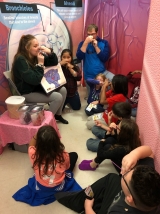-
Category 1
Selected in 2020
-
Grades: pre k - 5
School Setting: suburban
Town Population: 23,000
Student Enrollment: 227
Student Demographics:
Black/African American: 24%
Teacher/Student Ratio: 1:18
White/Caucasian: 50%
Hispanic: 15%
Hawaiian/Pacific Islander: 3%
Asian: 2%
Native American: 1%
Other: 5%
% Reduced Lunch: 50%
% ELL Learners: 10%
Founded: 1959 -
PRINCIPAL:
(Dixie) Dorothy Coleman -
CONTACT:
429 West Ash
Junction City, KS 66441
785-717-4674
DorothyColeman@usd475.org
Sheridan Elementary School
Junction City, KS
- Describe the most successful activity your school has initiated to strengthen ties to your community.
- We are partners with the 101st Battalion on Ft. Riley, enjoying a symbiotic relationship between soldiers and students. They work with us on Patriots Day in Sept. and Mad Scientist Day and Trick or Treat so Others Can Eat in Oct., attend our Holiday Celebration in Dec. run stations, and collect canned food items with us during our Healthy Heart Day in Feb., and set-up, run, and take down our Field Day event in May. We support our local Performing Arts Theater with splendid yearly productions. Teachers work after school for the popular Girls on the Run program to foster courage and confidence in our girls and the Planet Protector club provides students opportunities to learn positive environmental practices and maintain the school’s recycling efforts. Student council challenges the community to fund Pennies for Patients to support St. Jude Children’s Hospital. Jim Clark Chevrolet supports our food collection activities to donate to the Open Door and Wheels of Hope.
- What is the single most important factor in the success of your school that others could replicate?
- Climate and culture are EVERYTHING! Creating a warm and inclusive environment starts with leadership and their ability to effectively model expectations of behavior and procedural protocols for staff and students. Collaboration in developing those protocols, and consistency in communicating and demonstrating expectations, fosters success. Collaboration between the instructional coach, library staff, Special Ed., ELL, and teaching partners is provided through scheduled planning times. Approaching problems with a growth mindset, and extending grace when mistakes are made, creates an inclusive environment. Staff members encourage one another through birthday celebrations, and positive notes left during peer walkthroughs. Our meetings, including both class. and cert. staff members, begin with celebrations/teambuilding activities, followed by discussions of all aspects of student learning. All staff members understand the significance of the role they play in the success of our students.
- Describe the program or initiative that has had the greatest positive effect on student achievement, including closing achievement or opportunity gaps, if applicable.
- Once screening data is collected, the staff work together to review academic needs, form skill groups, delegate resources, and identify progress monitoring tools. Research based interventions are implemented targeting specific group needs. This process also addresses the needs of students that require extended learning opportunities. Grade levels meet at set times, thirty minutes daily, for each intensive reading and math group, outside of core instruction. Progress monitoring data is collected and analyzed weekly. Teachers know quickly if students need to continue with their current skill group, or if they have mastered the skill and can move to a different group. Our program is prescriptive to academic and socio-emotional needs, yielding evidence supporting positive outcomes in student achievement. Common plan time, collaboration, weekly meetings, monthly data focus meetings, counseling lessons, and staff professional development are geared to serve the needs of all children.
- Identify the critical professional development activities you use to improve teaching and student learning.
- Sheridan Elementary School staff implemented several impactful practices gained from professional development over the past few years. The Safe and Civil Schools Foundation training series produced a lasting positive impact on staff and students. From systemic reorganization of district and building expectations to effective common classroom management practices, we were able to increase staff job satisfaction and decrease disruptive behaviors among students. Repeating the school guidelines "Be Respectful, Be Responsible, Be Positive, and Have Integrity" daily with students helps maintain our focus on excellence. Our school also employed Trauma Informed School professional development in working with our most challenging students. Staff members were able to identify their own biases, recognize trauma, and create a toolkit of response options for deescalating difficult situations. Additionally, staff learned ways to remain regulated while dealing with dysregulated students or adults.
- Describe how data is used to improve student achievement and inform decision making.
- Data from the previous year is shared with the next grade level teacher, so they have an awareness of where their students were at the end of the last school year, allowing for a seamless transition. During the school year, the teachers collect formative data each quarter and report student progress and/or needs during the quarterly teacher/principal reviews. Classwork, assessments, and project-based learning activities from all content areas are analyzed and direct the teacher’s whole group and small group instruction. Progress monitoring data on each student’s specific needs are reviewed and goals are adjusted as the students meet expectations or gain mastery. During Focus meetings, teachers discuss best practices and instructional methods that yield the most growth. During PLC meetings, the instructional coach works with each teacher to pinpoint instructional needs, schedules modeling by co-teaching, and provides resources and strategies that are most impactful to each classroom.
- Describe your school culture and explain changes you’ve taken to improve it.
- One of the biggest changes we made several years ago, was to have monthly Whole Staff meetings. Certified AND Classified staff members are expected to attend and participate in teambuilding activities, complete professional development, and work through solutions to staff/parent/admin identified issues. As a whole school unit, we worked through Trauma Informed Schools, Growth Mindset, and various building and district initiatives. Including all staff members in building-wide initiatives increased our success rate, and revisiting expectations monthly help to ensure continued success. Other side effects of whole staff meetings are increased feelings of support and job satisfaction, as reported through our school surveys. Empowering all with defined levels of staff and student behavior, and helping each other through rough times through encouragement, makes our school a very special place to work.
Stats
-
Category 1
Selected in 2020
-
Grades: pre k - 5
School Setting: suburban
Town Population: 23,000
Student Enrollment: 227
Student Demographics:
Black/African American: 24%
Teacher/Student Ratio: 1:18
White/Caucasian: 50%
Hispanic: 15%
Hawaiian/Pacific Islander: 3%
Asian: 2%
Native American: 1%
Other: 5%
% Reduced Lunch: 50%
% ELL Learners: 10%
Founded: 1959 -
PRINCIPAL:
(Dixie) Dorothy Coleman -
CONTACT:
429 West Ash
Junction City, KS 66441
785-717-4674
DorothyColeman@usd475.org









